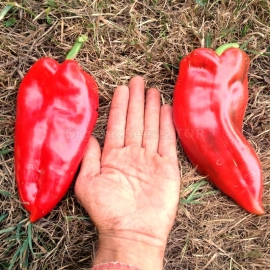



«Elephant Ears» - Organic Pepper Seeds
1.14 €
The Elephant Ears is a rare large sweet Paprika type from Croatia. It gets it's name from because the peppers flatten to a shape resembling an ear. It is also called Slonovo Uvo. In Croatia these peppers are roasted, stuffed and used to make sauces.
-
Heirloom Pepper «Elephant Ears»
The Elephant Ears is a rare large sweet Paprika type from Croatia. It gets it's name from because the peppers flatten to a shape resembling an ear. It is also called Slonovo Uvo.
In Croatia these peppers are roasted, stuffed and used to make sauces and condiments. In Serbia and Croatia it is famous for making a pepper preserve called Ajvar. Other peppers can be used to make Ajvar but the preferred pepper is Elephant Ears. It takes a few days to make but is worth the effort! The Elephant Ears chile plants produces peppers over 6 inches in length and over 4 inches wide. The fruits ripen from green to red. The Elephant Ears chile plants can grow up to 3 feet tall.
How to Grow
Sow from mid-February to early April indoors in pots or seed trays of seed compost. You will need to keep the temperature around 18-21°C (65-70°F), so use a propagator or place on a warm windowsill, with plastic bags over the pots to keep the heat and moisture in.
Young plants are available from garden centres in spring as an alternative to sowing. You can grow peppers in containers or in growing bags or in open ground, as long as it is a sheltered, sunny spot (at the base of a wall for instance). Transplant into 7.5-9cm (3-3.5in) pots when two true leaves have formed.
Further transfer plants to 30cm (12in) pots of good compost once the roots fill the 9cm (3in) pot in late April (if growing in a heated greenhouse), mid-May (if in an unheated greenhouse) or late May if growing outside.
Pinch out the growing tips of chillies when they are about 20cm (8in) tall to encourage bushiness; sideshoots (the shoots forming between the main stem and leaves) can be further pinched back if you want lots of smaller fruit. You may need to stake and tie plants in if they produce lots of heavy fruit. Water regularly and feed with a high potash liquid fertiliser once the first fruit has set.
